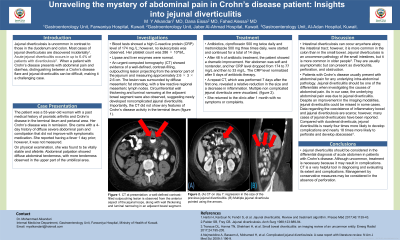Monday Poster Session
Category: IBD
P2232 - Unraveling the Mystery of Abdominal Pain in Crohn’s Disease Patient: Insights into Jejunal Diverticulitis
Monday, October 23, 2023
10:30 AM - 4:15 PM PT
Location: Exhibit Hall

Has Audio

Mohammad Y. Alkandari, MD
Kuwait Ministry of Health, Farwaniya hospital
Burlington, ON, Canada
Presenting Author(s)
Mohammad Y. Alkandari, MD1, Danah Mohammad, MD, FRCPC2, Fahed Alessa, MD3
1Kuwait Ministry of Health, Farwaniya hospital, Abdullah Al Mubarak, Al Farwaniyah, Kuwait; 2Kuwait Ministry of Health, Jaber Alahmad Hospital, Al Qadsiya, Al Asimah, Kuwait; 3Kuwait Ministry of Health, Adan Hospital, Abdulla Al Salem, Al Asimah, Kuwait
Introduction: Jejunal diverticulosis is an infrequent medical condition which is usually asymptomatic. Jejunal diverticulitis is one of the complications of this condition and is characterized by diarrhea and abdominal pain. Distinguishing between a disease flare and jejunal diverticulitis (JD) in Crohn's disease can be challenging.
Case Description/Methods: A 53-year-old female patient with a medical history of psoriatic arthritis and terminal ileum and perianal Crohn’s disease in remission. She presented with severe abdominal pain and constipation for 4 days. Abdominal examination revealed diffuse tenderness. An urgent Computed Tomography (CT) scan revealed jejunal diverticulitis (Figure 1). The C-reactive protein (CRP) was 174 mg/L with no leukocytosis. Antibiotic therapy was initiated for 14 days. A significant clinical improvement was observed within 48 hours of commencing antibiotics, and the CRP returned to normal on day 5. A follow-up CT scan demonstrated a reduction in the size of the jejunal diverticular out-pouch and no evidence of Crohn's disease activity (Figure 2). The patient remained asymptomatic with no complaints during the one-month follow-up visit.
Discussion: Jejunal diverticulosis is a rare pathological condition affecting the small intestine and is frequently observed in the elderly population. While jejunal diverticula are typically asymptomatic, they can present with diverticulitis, perforation, hemorrhage, and obstruction.
The coexistence of inflammatory bowel disease (IBD) and jejunal diverticulosis is rare. Moreover, there are very limited case reports are available. JD should be considered as a potential differential diagnosis when investigating the etiology of abdominal pain in patients with Crohn’s disease, although it can be difficult to differentiate it from a disease flare. In the present case, the underlying cause of the abdominal pain was identified as jejunal diverticulitis.
Diagnostic imaging is crucial to diagnose JD in patients with IBD, so that a prompt conservative management can be commenced to avoid complications.

Disclosures:
Mohammad Y. Alkandari, MD1, Danah Mohammad, MD, FRCPC2, Fahed Alessa, MD3. P2232 - Unraveling the Mystery of Abdominal Pain in Crohn’s Disease Patient: Insights into Jejunal Diverticulitis, ACG 2023 Annual Scientific Meeting Abstracts. Vancouver, BC, Canada: American College of Gastroenterology.
1Kuwait Ministry of Health, Farwaniya hospital, Abdullah Al Mubarak, Al Farwaniyah, Kuwait; 2Kuwait Ministry of Health, Jaber Alahmad Hospital, Al Qadsiya, Al Asimah, Kuwait; 3Kuwait Ministry of Health, Adan Hospital, Abdulla Al Salem, Al Asimah, Kuwait
Introduction: Jejunal diverticulosis is an infrequent medical condition which is usually asymptomatic. Jejunal diverticulitis is one of the complications of this condition and is characterized by diarrhea and abdominal pain. Distinguishing between a disease flare and jejunal diverticulitis (JD) in Crohn's disease can be challenging.
Case Description/Methods: A 53-year-old female patient with a medical history of psoriatic arthritis and terminal ileum and perianal Crohn’s disease in remission. She presented with severe abdominal pain and constipation for 4 days. Abdominal examination revealed diffuse tenderness. An urgent Computed Tomography (CT) scan revealed jejunal diverticulitis (Figure 1). The C-reactive protein (CRP) was 174 mg/L with no leukocytosis. Antibiotic therapy was initiated for 14 days. A significant clinical improvement was observed within 48 hours of commencing antibiotics, and the CRP returned to normal on day 5. A follow-up CT scan demonstrated a reduction in the size of the jejunal diverticular out-pouch and no evidence of Crohn's disease activity (Figure 2). The patient remained asymptomatic with no complaints during the one-month follow-up visit.
Discussion: Jejunal diverticulosis is a rare pathological condition affecting the small intestine and is frequently observed in the elderly population. While jejunal diverticula are typically asymptomatic, they can present with diverticulitis, perforation, hemorrhage, and obstruction.
The coexistence of inflammatory bowel disease (IBD) and jejunal diverticulosis is rare. Moreover, there are very limited case reports are available. JD should be considered as a potential differential diagnosis when investigating the etiology of abdominal pain in patients with Crohn’s disease, although it can be difficult to differentiate it from a disease flare. In the present case, the underlying cause of the abdominal pain was identified as jejunal diverticulitis.
Diagnostic imaging is crucial to diagnose JD in patients with IBD, so that a prompt conservative management can be commenced to avoid complications.

Figure: (A) CT-scan at presentation: well-defined contrast-filled out-pouching lesion from the anterior aspect of the jejunal loops, along with thickening of the wall and narrowing of the lumen in an adjacent bowel segment. (B) Day 7 CT-scan: regression in the size of the previous jejunal diverticulitis. (C) multiple jejunal diverticula.
Disclosures:
Mohammad Alkandari indicated no relevant financial relationships.
Danah Mohammad indicated no relevant financial relationships.
Fahed Alessa indicated no relevant financial relationships.
Mohammad Y. Alkandari, MD1, Danah Mohammad, MD, FRCPC2, Fahed Alessa, MD3. P2232 - Unraveling the Mystery of Abdominal Pain in Crohn’s Disease Patient: Insights into Jejunal Diverticulitis, ACG 2023 Annual Scientific Meeting Abstracts. Vancouver, BC, Canada: American College of Gastroenterology.
